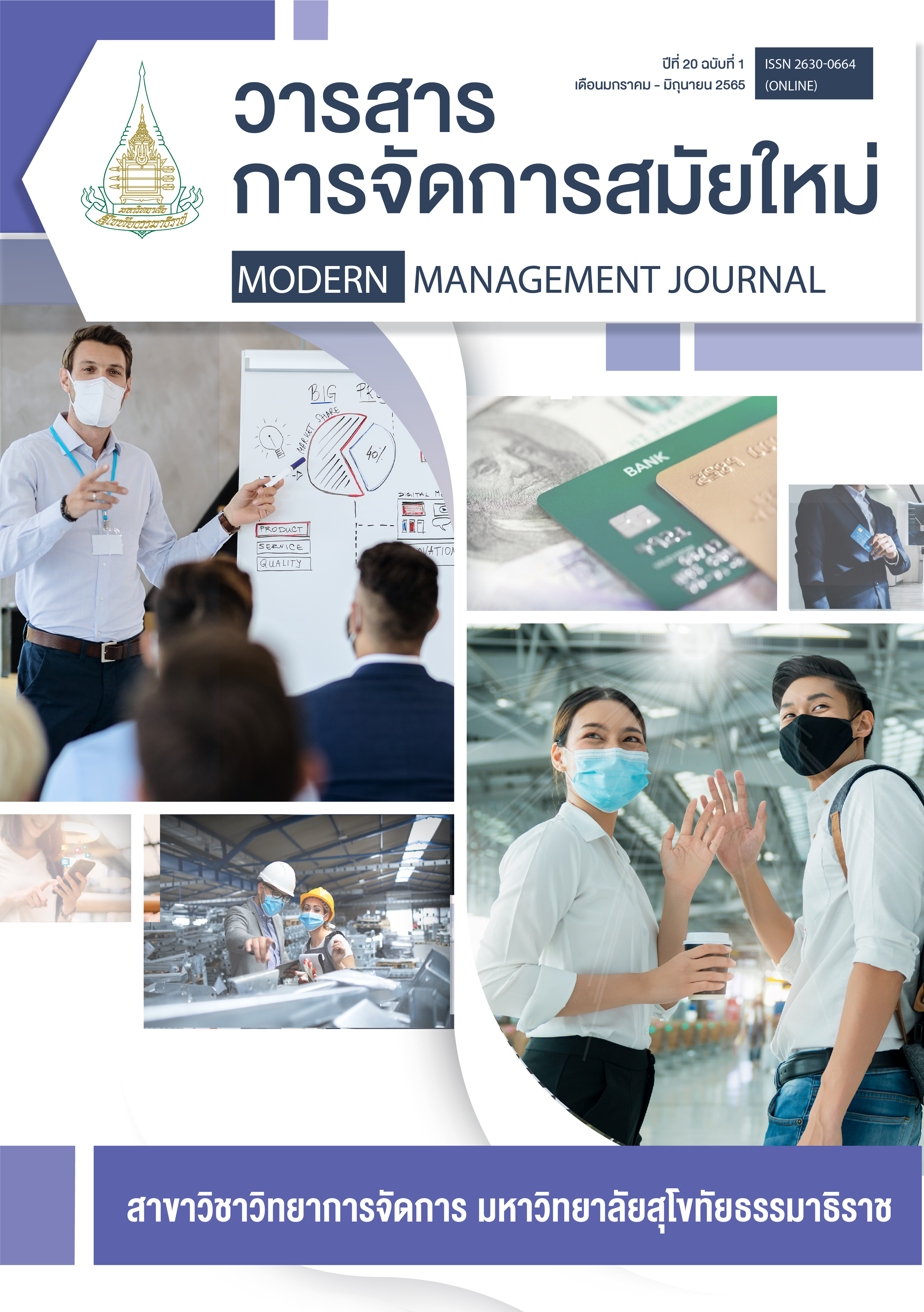Members Participation Model of Cluster Business Management: A under The Federation of Thai Industry
Keywords:
Members Participation Model, Cluster Business Management, Fashion and LifestyleAbstract
The purposes of this research were 1) to study the participation model of members in fashion and lifestyle cluster, the Federation of Thai Industries, 2) to synthesize the participation model of members in fashion and lifestyle cluster, the Federation of Thai Industries, and 3) to synthesize the strategies for member participation in cluster business management.
The research is a qualitative research. The data was collected by interviewing the group with the members of the committee of 9 industry groups, 36 samples. The interview data were used to synthesize the participation model by using diamond model analysis, SWOT analysis model, and TOWS Matrix analysis. The result of synthesis data was proposed to the cluster consultants in order to choose the suitable model and member participation strategy.
The results of the research found that 1) The model of member participation in the business group management comes from the industry group representative system and elected one of their members to be Cluster Management Committee based on the regulations of the Federation of Thai Industries. They are responsible for setting activities, meeting agendas, and informing the general members to participate in the cluster activities. 2) Based on the synthesis of appropriate member participation models in the Fashion and Lifestyle Cluster, it was found that the cluster member participation was limited from the regulations of the Federation of Thai Industries. Meanwhile, members have the opportunity to seek cooperation between the industry itself, as appropriate, and relationships within the supply chain, and 3) From the synthesis of member participation strategies in cluster business management, it was found that there were four sub-strategies such as the proactive strategy emphasizes participation in supply chain activities, and cluster product promotion activities with the government sector. The passive strategy emphasizes participation in new market-seeking activities and negotiations with financial institutions, both public and private sectors. The corrective strategy emphasizes participation with the government in negotiations to resolve trade privileges with trading partners, and the preventive strategies emphasize participation in finding new sources of raw materials and proposed business projects for government funding.
References
American Public Transportation Association. (2019). The Role of Transit in Support of High Growth Business Clusters in the U.S. สืบค้น 3 กันยายน 2562 จาก https://www. apta.com/ wp-content/uploads/Resources/resources/ reportsandpublications /Documents/ TransitHighGrowthClustersUS-Final2013-1124-1.pdf
Asian, I., Kumpikaite, V. and Cinar, O. (2012). Creating strategies from tows matrix for strategic sustainable development of Kipaş Group. Journal of Business Economics and Management Vol. 13(1), pp. 95-110.
Bell, M. & Albu, M. (1999). Knowledge Systems and Technological Dynamism in Industrial Clusters in Developing Countries. World Development, Vol. 27, Iss. 9 pp. 1715-1734.
BOP Consulting (2017). The East London Fashion Cluster. Draft Strategy and Action Plan, February 2017.
Cohen, J.M., & Uphoff, N.T. (1977). Rural Participation: Concepts and Measures for Project Design, Implementation and Evaluation. In Rural Development Monograph No.2 The Rural Development Committee Center for International Studies, Cornell University, January.
Cohen, J.M., & Uphoff, N.T. (1980). Participations place in rural development: Seeking clarity through specificity. World Development Vol. 8 (3), pp. 213-235.
Giuliani, E. (2005). Cluster Absorptive Capacity: Why Some Clusters Forge Ahead and Others Lag Behind? European Urban and Regional Studies Vol. 12, Iss.3. PP.269–88.
Inter-American Development Bank. (2017). Cluster in the Caribbean. สืบค้น 30 กันยายน 2562 จาก
https://pdfs.semanticscholar.org/ea7a/77c86e15c61fcbc46f0bef11e8f 3fce79b64.pdf.
JP Morgan Chase & Co. (2015) Accelerating Cluster Growth: A Playbook for City Leaders. Executive Summary, June 2018)
Khatsenko, E., S. (2019). The Sustainability of Cluster Business Structure in a Crisis. Voprosy Regionalnoj ekonomiki Vol. 39 (2) pp. 96-100
Kulshrestha, S. & Puri, P. (2017). Tows Analysis for Strategic Choice of Business Opportunity and Sustainable Growth of Small Businesses. Pacific Business Review International Vol. 10 Iss. 5. pp. 144-152.
Lyon, F. & Atherton, A. (2000). A Business view of Clustering: Lessons for Cluster Development Policies. University of Durham. Foundation for SME Development.
Manicham, A., R., S. (2016). Future of Cluster Development-Lessons from Energy Valley, The Netherlands. A thesis of London South Bank University for the degree of Doctor in Philosophy.
Malta Enterprise. (2014). Cluster in Business สืบค้น 12 มิถุนายน 2562 จาก https://www.maltaen terprise.com/sites/default/files/clusters.pdf
Maxwell Stamp Plc. (2013). Support to Cluster Development in Croatia: Cluster Development Handbook สืบค้น 12 ธันวาคม 2562 จาก https://www.enterprise-development.org/wp-content/uploads /GuidelinesforClusterDevelopment.pdf
Mefford, C. (2010). Washington State Fashion and Apparel Industry Cluster Study. Community Attributes International.
National Institute of Economic and Social Research. (2017). Industrial Clusters in England. London: Department for Business, Energy & Industrial Strategy.
Porter, Michael E. (1998) Clusters and the New Economics of Competition Documentation. Harvard Business Review, Boston.
Schmitz, H. & Nadvi, K. (1999). Clustering and Industriakization: Introduction. World Development, Vol. 27, Iss. 9 pp. 1503-1514.
Swansburg, R. C. (1996). Management and leadership for nurse managers, 2nd edition. Boston: Jones and Bartlett.
The U.S. Agency for International Development (USAID) (2003). Software/ICT Cluster Vietnam Competitiveness Initiative (VNCI). Hanoi, Vietnam.
Wheelen, L., T. and Hunger, D., J. (2012). Strategic Management and Business Policy toward Global Sustainability, 13th edition. Boston: Pearson Education, Inc.
World Bank. (2004). Development and Poverty Reduction: Looking Back, Looking Ahead, The World Bank, Washington 2004
Zhang, Z., To, C. & Cao, N. (2004). How do Industry Cluster Success: A Case Study in China’s Textiles and Apparel Industries. Journal of Textile and Apparel, Technology and Management, Vol. 4, Iss. 2 pp. 1-10.
Downloads
Published
How to Cite
Issue
Section
License
Copyright (c) 2022 Modern Management Journal

This work is licensed under a Creative Commons Attribution-NonCommercial-NoDerivatives 4.0 International License.



